More than 500 million smallholders provide home and livelihood to more than 2 billion people. Many of them remain in dire poverty. One reason is the lack of access to financial services that would allow these farmers to manage their cash flow, get credit to invest in productivity increases, or manage risks through insurance. Providing microfinance services to smallholders has proven difficult due to, among other issues, their high-risk profiles and a highly dispersed population. But new solutions are emerging. And they are badly needed, as smallholders are important partners in fighting hunger and ensuring nutrition for a rapidly growing population in developing countries and to mitigate and adapt to the effects of climate change.
Solutions can be categorized along three types of services: credit/savings, insurance, and value chain finance. In general, adapted financial services need to take into account the family-led farming system, where a family jointly invest in, works on, and lives off the farm. Furthermore, products need to reflect the largely unforeseeable risks related to weather, pest and prices and cater to specific financing needs related to the cycle of agricultural production. For instance, many microfinance providers in rural areas (still) offer mostly short-term and relatively high-priced loans, which are generally not suitable to agricultural production.
Value chain finance is probably the solution used most by smallholders. In fact, business partners of smallholders integrate financial services into their offerings along the whole value chain. Fertilizers are sold on credit or provided by the buyer in turn for a part of the harvest. The harvest itself can be used to get credit from warehouses. Companies may even lease machines or cows. Smallholders can manage lean periods before harvests better if they receive upfront payment from sourcing companies. But not only smallholders, also local processing firms often lack access to finance. Financial service providers may collaborate with value chain players to analyse the various financial needs in the value chain and enable these players to offer more and more professional services by backing them up with specialized products.
Credit & Savings: Many credit providers have failed to profitably serve farmers because they often use products and services designed for entrepreneurs (who have fairly stable and steady income from their businesses) to serve farmers. This mis-match is the primary cause of default on loans by farming households. Helping microfinance providers to adapt their financial products to the specific needs of farmers by providing them technical assistance is one solution to overcome these challenges. Connecting loans to savings is an efficient strategy to minimize risks in lending. In fact, smallholders may prefer adapted savings products to avoid indebtedness.
Companies sourcing from or working with smallholders can engage in partnerships with NGOs and microfinance providers to improve the access to and the quality of financial services provided. Subsidies on credits or financial aid provided by governments could be an entry point to encourage MFIs to serve smallholders.
Microinsurance can protect smallholders from losing their assets due to a failed harvest. In the absence of insurance, smallholders manage the loss by selling assets, leaving them worse off in the next season. Index-based insurances have been developed to minimize administrative costs and fraud. Here, payments are triggered when rainfall or other events reach a certain benchmark. Besides requiring infrastructure such as weather stations that don’t exist yet in many places, index-based insurances cannot fully guarantee that the farmer will actually be covered in case of loss, since it may have occurred below the threshold (the so-called “basis risk”). Using indices as a means to reinsure the insurance portfolios of aggregators such as cooperative offers a way out of the dilemma. Aggregators can then assess the damage individually and share the covariant risk via reinsurance. Value chain insurance would be another option to reduce administrative costs. Here, companies that buy from or sell to many small farmers could bundle insurance products into their contracts, and assess damage when required.
At least as devastating as the weather can be global commodity markets and fluctuating prices. Smallholders that have established relationships with buyers often hedge their risk by negotiating a minimum price. This solution only works if the farmer cooperates with one major buyer, a model that is mainly used for cash crops such as cocoa or coffee. Larger farms sell futures in order to adjust their risk profile over time, and similar products could be developed for small farms.
Agricultural finance is advancing in many countries, as documented in the recent IFAD/CGAP study “Managing risks and designing products for agricultural microfinance.” Still, much remains to be done and many of the promising innovations yet have to gain broad reach.
PlaNet Finance Deutschland e.V., in collaboration with Endeva and the foundation UP Micro Loans, hosted a MicroFinance Breakfast event on November 21st with a focus on agri-micro-finance. The breakfast built on the recently published report written by Endeva on behalf of the German development agency GIZ and the German development ministry BMZ on “Growing Business with Smallholders.” The blog post is a summary of insights from the discussion.











One Response
Thanks for flagging up the issue of finance for smallholders…it is of course a longstanding problem and I get constantly reminded of it when visiting smallholder producer organisations worldwide… actually, the problem seems to get rather worse…it is encouraging that new models and forms of micro-finance/ micro-insurance are emerging like the ones pointed out…what I didn’t see in the blog was any indication if the recent trend around social impact investment, crowdfunding, etc. could provide some contribution “to gain broad reach“?